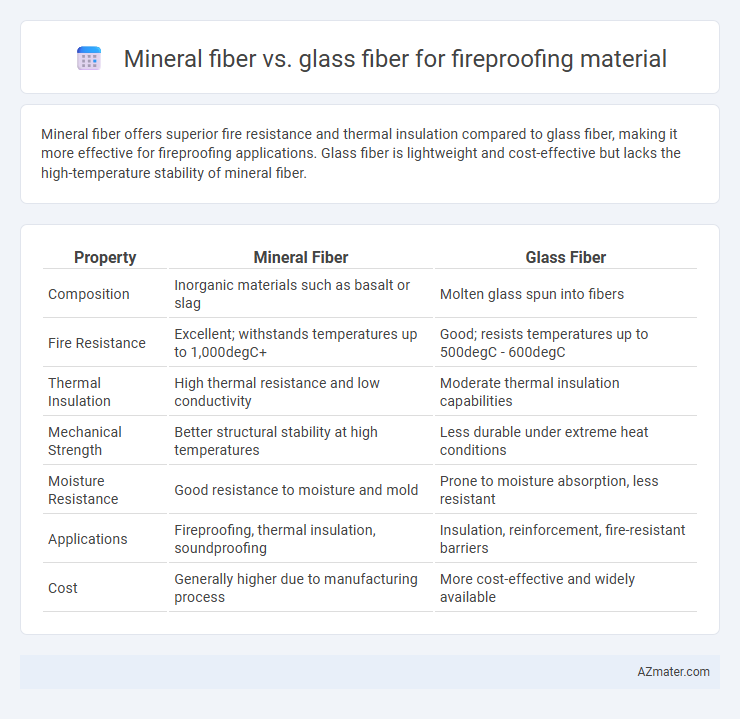Mineral fiber offers superior fire resistance and thermal insulation compared to glass fiber, making it more effective for fireproofing applications. Glass fiber is lightweight and cost-effective but lacks the high-temperature stability of mineral fiber.
Table of Comparison
| Property | Mineral Fiber | Glass Fiber |
|---|---|---|
| Composition | Inorganic materials such as basalt or slag | Molten glass spun into fibers |
| Fire Resistance | Excellent; withstands temperatures up to 1,000degC+ | Good; resists temperatures up to 500degC - 600degC |
| Thermal Insulation | High thermal resistance and low conductivity | Moderate thermal insulation capabilities |
| Mechanical Strength | Better structural stability at high temperatures | Less durable under extreme heat conditions |
| Moisture Resistance | Good resistance to moisture and mold | Prone to moisture absorption, less resistant |
| Applications | Fireproofing, thermal insulation, soundproofing | Insulation, reinforcement, fire-resistant barriers |
| Cost | Generally higher due to manufacturing process | More cost-effective and widely available |
Introduction: Importance of Fireproofing Materials
Fireproofing materials such as mineral fiber and glass fiber play a critical role in enhancing building safety by preventing the rapid spread of flames and maintaining structural integrity during fires. Mineral fiber offers superior thermal insulation and higher melting points, making it highly effective in extreme fire conditions. Glass fiber provides excellent durability and cost-effectiveness, serving as a reliable choice for fire-resistant insulation in various construction applications.
What Are Mineral Fiber and Glass Fiber?
Mineral fiber, composed of naturally occurring materials like basalt or slag, offers superior fire resistance and thermal insulation compared to glass fiber, which is made from molten silica and recycled glass. Both fibers are used in fireproofing applications, but mineral fiber's higher melting point, often above 1000degC, makes it more effective in extreme temperatures. Glass fiber provides good thermal insulation and is cost-effective, but it melts at lower temperatures around 650degC, limiting its use in high-fire-risk environments.
Composition Differences: Mineral Fiber vs Glass Fiber
Mineral fiber fireproofing primarily consists of naturally occurring minerals like basalt or diabase, which are melted and spun into fibers, offering excellent thermal insulation and fire resistance due to their inorganic composition. Glass fiber is produced by melting silica sand mixed with other raw materials such as soda ash and limestone, then drawn into thin strands that provide good thermal and sound insulation but may exhibit lower fire resistance compared to mineral fibers. The differing chemical compositions affect melting points, durability under high temperatures, and applicability in fireproofing systems, making mineral fibers more suitable for high-temperature fireproofing scenarios.
Fire Resistance Performance Comparison
Mineral fiber and glass fiber both serve as effective fireproofing materials, but mineral fiber exhibits superior fire resistance due to its higher melting point, often exceeding 1000degC, compared to glass fiber's melting point around 700degC. Mineral fibers, typically made from rock or slag, provide enhanced thermal insulation and do not release toxic gases when exposed to high temperatures, making them preferable in fire-critical applications. Fire resistance performance tests consistently show mineral fiber maintaining structural integrity longer under extreme heat, whereas glass fiber may soften or degrade more quickly.
Thermal Insulation Properties
Mineral fiber exhibits superior thermal insulation properties compared to glass fiber due to its higher melting point and greater density, which enhances fire resistance and maintains structural integrity at extreme temperatures. Glass fiber offers good insulation but tends to lose efficiency under prolonged high heat exposure, making mineral fiber more suitable for fireproofing applications in industrial and commercial buildings. The thermal conductivity of mineral fiber typically ranges from 0.03 to 0.05 W/m*K, providing better heat retention and energy efficiency in fire-resistant environments.
Installation Methods and Ease of Application
Mineral fiber fireproofing materials typically require wet spray or trowel application methods, demanding skilled labor for proper mixing and adherence, which can extend installation time. Glass fiber fireproofing offers easier handling due to its lightweight and flexibility, often applied as batts or blankets that simplify fitting around structures and speed up installation. Choosing between the two depends on project complexity, with glass fiber favored for quicker, less labor-intensive applications and mineral fiber preferred for enhanced fire resistance in critical areas.
Durability and Longevity in Fireproofing
Mineral fiber offers superior durability and longevity in fireproofing applications due to its higher melting point and resistance to chemical degradation compared to glass fiber. Glass fiber can lose structural integrity over time when exposed to prolonged high temperatures, whereas mineral fiber maintains its fire-resistant properties and structural stability under extreme heat conditions. Selecting mineral fiber enhances the lifespan and effectiveness of fireproofing systems in industrial and commercial buildings.
Environmental Impact and Sustainability
Mineral fiber fireproofing materials exhibit lower environmental impact due to their natural raw material sources and higher recyclability compared to glass fiber, which often relies on energy-intensive manufacturing of raw materials like silica sand and recycled glass. Mineral fibers typically generate less airborne particulate pollution during installation and disposal, reducing occupational and environmental health risks. Sustainable fireproofing benefits from mineral fibers' longer lifecycle and reduced carbon footprint, making them preferable over glass fibers in eco-conscious construction projects.
Cost Analysis: Mineral Fiber vs Glass Fiber
Mineral fiber fireproofing materials generally cost more than glass fiber due to higher raw material and manufacturing expenses, but offer superior fire resistance and durability. Glass fiber is more economical with lower production costs, making it a preferred option for budget-sensitive projects that require moderate fireproofing performance. Long-term savings on mineral fiber arise from reduced maintenance and replacement needs, offsetting the initial higher investment compared to glass fiber alternatives.
Choosing the Right Fireproofing Material: Key Considerations
Mineral fiber offers superior fire resistance and thermal insulation compared to glass fiber, making it ideal for high-temperature applications in fireproofing. Glass fiber is lighter and more cost-effective but less effective in withstanding extreme heat or prolonged fire exposure. When choosing fireproofing materials, prioritize heat tolerance, durability, and specific application requirements to ensure optimal safety and performance.

Infographic: Mineral fiber vs Glass fiber for Fireproofing material
 azmater.com
azmater.com